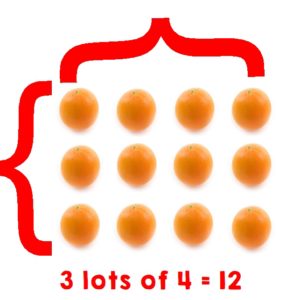Times tables are extremely important. Your child will need to understand and learn multiplication facts up to 12 x 12 by the end of Year 6.
Children need to understand multiplication before they begin learning times tables.
What is multiplication? Put simply, multiplication is an easy way to add a number more than once. In other words, 3 x 5 is the same calculation as 5 + 5 + 5.
You can use anything to show your child multiplication in real life: pencils, spoons, anything at all. For example, take five apples to demonstrate ‘one lot of five’. Then take five more apples to demonstrate ‘two lots of five’ and so on. You can use Lego or other blocks to convey all sorts of maths ideas. This video gives you an idea of how to do this:
Until your child understands the concept of multiplication, there will be little point in learning times tables. What’s more, if your child doesn’t have a good grasp of simple addition (adding up), you will have a tough job in helping them understand times tables. So you might need to take your time and keep practising addition or just counting in 2s until your child is ready to move on. Don’t push it. You want times tables to be ‘real’ and not just some sets of numbers your child has memorised like a robot. If you take the right approach, division is very easily learned alongside times tables, so it’s worth taking your time.
Make times tables matching cards
You can print out our Times Table Matching Cards – we have made a blank and a 2 times table example – or you can simply make your own very easily. Use them in the following ways:
-
Play snap.
-
Match up in pairs, i.e. match 3 x 2 with 6.
-
Make matching more challenging: lay the cards out face down and take it in turns to find matching pairs.
-
Lay out all the cards then remove one. Ask your child to identify which card is missing
Other games you can play
-
Telepathy – ask your child to ‘read your mind’ to guess which multiplication fact you are thinking of.
-
Noughts and crosses – write a multiplication question in each square in your noughts and crosses grid. Players must supply the answer in order to place their nought or cross in a square.
-
Bingo – each player chooses six multiplication facts from the times table you are working on. The caller gives the first part of the multiplication fact, e.g. “3 x 2 … 6 x 2 … 9 x 2”. Each player can cross off their number when the multiplication fact is called. The winner is the first player to cross off all six numbers.
Other Times Table Resources
Once your child has covered the times tables, you will want to work on speed of recall. There is an abundance of resources to help you with this. YouTube is a rich source of times tables songs (some dreadful – and therefore very memorable!). You can also buy workbooks to support times tables. Just have a look in your local bookstore and choose the one you think will best engage your child’s interest.
Better Tuition can help with times tables


